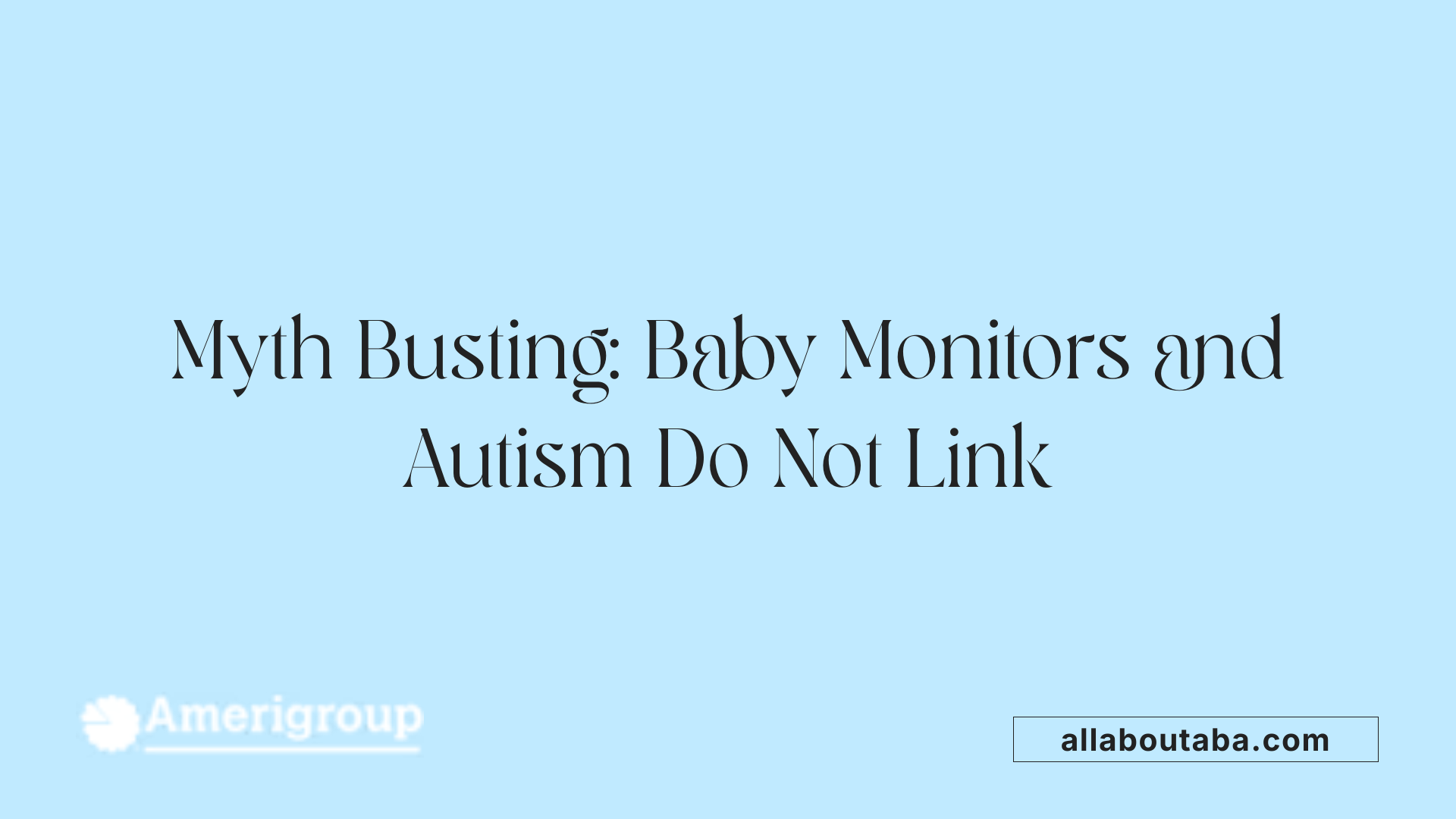Do Baby Monitors Cause Autism?
Understanding the Concerns and Science Behind Baby Monitors and Autism Risk
The rapid proliferation of baby monitors has raised questions among parents and caregivers about their safety, particularly whether these devices could contribute to autism. While concerns are often fueled by misconceptions and misinformation, scientific evidence provides a clearer picture. This article explores the current research on the relationship between baby monitors, screen time, electromagnetic field exposure, and autism spectrum disorder (ASD). It also discusses the health risks associated with electromagnetic fields (EMFs) and offers guidelines from experts to help parents make informed decisions about device usage during early childhood.
Assessing the Evidence: Do Baby Monitors Cause Autism?
What does the research say about misconceptions linking baby monitors and autism?
Current scientific research indicates that there is no causal link between the use of baby monitors and the development of autism spectrum disorder (ASD). While concerns about electronic devices influencing childhood developmental conditions are sometimes expressed, studies have not established any direct connection between baby monitors and ASD.
Autism is a complex neurodevelopmental condition primarily influenced by genetic factors, with environmental elements playing a modifying role. Usage of devices like baby monitors, which are common tools for ensuring infant safety, has not been shown to contribute to the onset of autism.
Various studies reviewed in recent systematic analyses focus on broader screen time exposure rather than specific devices like baby monitors. These studies reveal that prolonged exposure to screens—especially in early childhood—may be associated with increased ASD risk and developmental delays. However, they do not implicate baby monitors as a causative agent.
Health authorities, including the American Academy of Pediatrics, emphasize the importance of early screening, appropriate intervention, and moderated screen time. They generally warn against excessive screen exposure but do not identify baby monitors as harmful or linked to autism.
It is essential to differentiate tools intended for child safety from potential causes of developmental disorders. Current evidence clearly suggests that medical and developmental screenings, genetic factors, and environment are the main factors in autism risk, not consumer baby monitors.
Additional context
Research on the topic, often summarized under the search term 'research on baby monitors and autism causation,' reinforces that no scientific basis exists for claims linking baby monitors with ASD. Instead, focus should be maintained on proven risk factors and recommended practices for promoting healthy development in children.
Screen Time and Autism: What the Science Tells Us

Review evidence relating early screen exposure with increased ASD risk
Recent comprehensive reviews indicate a notable association between the amount of time children spend on screens and the risk of developing Autism Spectrum Disorder (ASD). Specifically, children exposed to screens before the age of 2, and more than two hours daily, show higher scores on ASD screening tools such as the Modified Checklist for Autism in Toddlers, Revised (M-CHAT-R). A cohort study highlighted that early exposure—especially before age 2—acts as a significant factor in ASD development.
Studies also demonstrate that longer daily screen time correlates with more severe ASD symptoms, particularly sensory issues and language delays. For example, children with more severe autism tend to look at video devices more, which may reflect their difficulty interacting with others rather than causing ASD directly.
Recent research even mentions the term “virtual autism,” emphasizing the potential risks linked with excessive screen exposure during critical developmental windows.
Discuss the impact of early screen time on language, social, and emotional development
Excessive screen time can hinder crucial developmental milestones. It can impair speech development, delay language acquisition, and negatively affect emotional and social skills. Children with autism are especially vulnerable; overexposure to screens can cause sensory overload, disrupt sleep, and hinder their ability to interact socially.
While screens can offer benefits such as visual learning, calming effects, and controlled social interaction, too much exposure may lead to negative outcomes like social withdrawal, obsessive behaviors, social anxiety, and lowered attention spans. These effects are particularly pronounced in children with existing autism, who may spend a significant portion of their free time on screens—up to 64.2% among young adults with ASD.
Summarize recommendations from pediatric health authorities
Guidelines from the American Academy of Pediatrics (AAP) recommend no screen time for children under 18 to 24 months, emphasizing the importance of parent-child interaction. For children aged 2 to 5 years, limits are set at no more than one hour per day of high-quality programming.
To manage screen time effectively, it is advised to regulate usage, make screens a reward rather than a default activity, and monitor online activity. Warning systems like countdown notifications can help children understand boundaries. Such measures help mitigate potential developmental risks while leveraging the benefits of screens for learning and calming.
In conclusion, while no direct causal link has been established between screen time—including using baby monitors—and autism, evidence suggests that excessive early exposure is associated with increased ASD risk and developmental delays. Adhering to recommended limits and supervising usage are vital to support healthy developmental trajectories.
Electromagnetic Fields (EMF) and Infant Health Risks

Are there health risks associated with EMF exposure from baby monitors?
There are concerns about potential health risks related to electromagnetic field (EMF) emissions from wireless baby monitors. These devices operate by emitting microwave radiation continuously to transmit audio and video signals. Infants are especially vulnerable to EMF because their brains are still developing, and their skulls are thinner, which can lead to higher absorption levels of EMF.
Some studies have suggested possible associations between high magnetic field exposure and health issues in children, such as an increased risk of childhood leukemia. However, the scientific community has not established conclusive evidence definitively linking EMF exposure from monitors to specific health problems.
To minimize potential risks, health experts recommend keeping baby monitors at a safe distance from infants and considering wired alternatives, which do not emit EMF during operation. Practicing these precautions can help reduce unnecessary exposure during critical early developmental periods.
How can parents manage EMF exposure effectively?
- Use wired monitors when possible.
- Keep wireless monitors away from the baby's sleep area.
- Turn off monitor transmitters when not in use.
- Check for the lowest emission devices on the market.
- Follow manufacturer safety instructions.
While more research is needed, applying these safety measures helps safeguard infants from unnecessary electromagnetic exposure, supporting healthier early development.
Benefits and Challenges of Screen Use in Autism
How can screen time support children with autism?
Screen use can be beneficial for children with autism when used thoughtfully. Many children with ASD find comfort in predictable visual stimuli, such as videos and digital games, which can have a calming effect. Screen time also offers visual and auditory learning tools that help children understand concepts and develop communication skills.
Additionally, controlled screen interactions can provide a safe environment for social engagement. Online activities and apps can serve as bridges to social skills development and can help reduce feelings of isolation. Some studies highlight that screen time helps children with autism manage sensory overload by offering structured sensory inputs.
Despite these benefits, it’s important to manage screen use carefully. The American Academy of Pediatrics recommends limited screen time, emphasizing active engagement over passive consumption, especially for very young children.
What are the potential negative impacts of excessive screen exposure?
Research indicates that too much screen time can hinder development in children with ASD. Excessive exposure has been linked to worsened sensory issues, developmental delays—especially in speech and language—and behavioral problems like obsessive-compulsive behaviors and social anxiety.
Longer screen duration is also associated with more severe ASD symptoms, including sensory sensitivities and emotional regulation challenges. It can disrupt sleep patterns, increase stress hormones, and contribute to decreased physical activity, raising the risk for obesity.
Moreover, for children with more severe autism, excessive screen time might be a symptom of their difficulty with social interaction rather than a cause. Still, it’s crucial to monitor and limit screen exposure to avoid sensory overload and promote healthier development.
How can parents and caregivers manage screen time effectively?
Effective management involves setting clear boundaries. The American Academy of Pediatrics advocates for no screen time before 18-24 months, except for video chatting. For children aged 2 to 5, limiting screen time to one hour per day is recommended.
Parents can make screen time a reward, provide countdown warnings, and supervise content to avoid inappropriate material. Using the screen as a tool for visual learning and calming, while avoiding excessive exposure, helps balance benefits and risks.
Creating routines that include physical activity, social interactions, and free play is essential. Monitoring online activity and making use of parental controls further ensures that screen time remains a positive supplement to development. When used appropriately, screens can support children with autism without overshadowing vital real-world interactions.
Addressing Misconceptions and Providing Clear Facts

What does the research say about misconceptions linking baby monitors and autism?
There is a common misconception that baby monitors or other electronic devices can cause autism in children. However, scientific research clearly shows that there is no evidence to support a causal relationship between the use of baby monitors and the development of autism spectrum disorder (ASD). Autism is recognized as a complex neurodevelopmental condition with origins deeply rooted in genetic and environmental factors that are not influenced by electronic devices.
Extensive studies and reviews, including the systematic review discussed earlier, focus on screen exposure and its impact on ASD risk. These investigations highlight that while excessive screen time can be associated with higher ASD risk scores and developmental challenges, the mere use of devices like baby monitors does not contribute to the condition.
Organizations such as the American Academy of Pediatrics emphasize the importance of early screening and intervention for autism. They recommend limiting screen time based on age to promote healthy development but firmly state that devices like baby monitors are not linked to causing autism.
Understanding the complex causes of autism helps dispel myths and refocus efforts on evidence-based strategies such as early diagnosis, appropriate intervention, and fostering stimulating environments that support social and cognitive growth. It’s essential for parents and caregivers to rely on reputable sources and medical advice rather than myths or misconceptions.
For additional clarity, a helpful search query is 'debunking myths about baby monitors and autism,' which offers further evidence and expert opinions affirming the safety and non-causality of such devices in ASD development.
Making Informed Choices for Child Development and Safety
Parents should base their decisions on credible scientific evidence, following guidelines for screen time and EMF exposure. While concerns about environmental factors are valid, current research does not support the idea that baby monitors cause autism. Instead, focusing on healthy developmental activities, minimizing unnecessary screen exposure, and following expert recommendations will better support children’s health and well-being.
References
- Early Screen-Time Exposure and Its Association With Risk of ...
- Autism and screen time: Are they related? - Norton Children's Hospital
- Autism and Screen Time: A Must-Know Connection for Parents
- Continuous electronic fetal monitoring during prolonged labor may ...
- Autism Screening & Assessments
- Early Screen-Time Exposure and Its Association With Risk of ...
- Screen time and preschool children - Canadian Paediatric Society
Other articles
Recent articles

Best Practices For Telehealth Autism Therapy

How To Help Autistic Children Develop Friendship Skills

How Schools Can Support Autistic Students In Career Prep

Best Strategies For Autism-Friendly Event Planning

Understanding Noncontingent Reinforcement In Autism Behavior Plans

How Drama Therapy Benefits Autistic Individuals

Best Practices For Autism-Friendly Fitness And Recreation Centers

Best Ways To Promote Healthy Social Media Use For Autistic Teens

How To Help Autistic Children Cope With Public Speaking

Autism And Strategies For Managing Unexpected Changes

Best Podcasts About Autism For Parents And Educators

Autism And The Impact Of Seasonal Changes On Behavior

The Role Of Diet In Managing Co-Occurring Conditions With Autism

Sleep Challenges In Autism And Practical Solutions

Best Ways To Build Daily Routines For Autistic Children

Best Practices For Supporting Autistic Entrepreneurs

Autism And Strategies For Navigating Large Social Gatherings

Adaptive Sports And Recreational Activities For People With Autism

Autism And The Benefits Of Story-Based Learning Activities

Understanding The Role Of Play In Autism Development

Autism And The Impact Of Environmental Noise On Learning

How To Create Autism-Friendly Community Spaces

Autism And Chronic Health Conditions: What To Know

The Role Of Care Managers In Autism Life Planning

How To Teach Social Boundaries To Autistic Children

How Autistic Individuals Experience Empathy Differently

How To Support Autistic Employees In Remote Work Settings

Autism And The Relationship Between Motor Skills And Learning

How To Create Community Resource Guides For Autism Families

How To Teach Daily Living Skills To Autistic Teens

Autism And The Impact Of Mind-Body Practices On Stress Reduction

Autism And The Benefits Of Outdoor Group Activities

How To Create Autism-Friendly Sensory Paths In Schools

Best Practices For Autism-Friendly Park And Recreation Areas

Autism And Strategies For Reducing School Refusal

Supporting Autistic Individuals In Public Speaking

The Role Of Diet In Managing Autism Symptoms

The Benefits Of Gardening Clubs For Autism Social Development

How To Prepare Autistic Children For Dental Visits

Autism And Employment: Career Paths That Work

Best Practices For Autism-Friendly Hotels And Lodging

The Impact Of Screen Time On Autism Development

Autism Screening Tools For Early Childhood

The Role Of Physical Exercise In Autism Therapy

Best Strategies For Supporting Autistic College Students

The Role Of Technology In Autism Early Detection

Sensory-Friendly Classroom Design Ideas For Autistic Students

The Role Of Speech Therapy In Building Social Communication Skills

Best Strategies For Handling Autistic Burnout In Adults

Autism And The Importance Of Predictability In Routine

Autism And Peer Education: Teaching Acceptance In Schools

Best Practices For Sensory-Friendly Libraries And Reading Rooms

Self-Advocacy Skills For Autistic Adults

The Role Of Technology In Autism Peer Communication

Promoting Physical Activity In Children With Autism

How To Prepare Autistic Children For Medical Procedures

The Role Of Social Media In Autism Advocacy And Awareness

The Impact Of Sensory Rooms In Public Facilities For Autism

How To Create An Autism-Friendly Holiday Celebration

Best Practices For Inclusive Education For Autistic Students

Autism And Mental Health: Recognizing Signs Of Distress

Best Practices For Sensory-Friendly Waiting Rooms

The Role Of Teachers In Early Autism Red Flag Identification

Autism-Friendly Housing Design Features

Autism-Friendly Housing Design Features

How Environmental Modifications Improve Autism Outcomes

Autism And Technology-Based Learning Tools

Supporting Autistic Children Through Changes In Routine

The Link Between Autism And Working Memory Challenges

Best Practices For Autism-Friendly Cooking Classes

Autism And The Benefits Of Structured Music Lessons

Best Books To Teach Kids About Autism Acceptance

Sensory Diets And Their Benefits For Autism Management

How To Prepare Autistic Teens For Driver’s Education

How To Teach Autistic Teens About Healthy Relationships

The Role Of Visual Prompts In Building Daily Habits For Autism

Addressing Sleep Regression In Children With Autism

Understanding Social Stories And How They Help Autistic Children

Navigating Insurance Coverage For Autism Therapy Services

How To Prepare Autistic Adults For Independent Travel

Supporting Autistic Individuals In Volunteer Work

How Mindfulness Practices Can Support Autism Well-Being

Understanding Hyperfocus And Special Interests In Autism

Understanding Stimming As A Self-Regulation Tool

Sensory-Based Interventions For Autism At Home

Best Ways To Introduce Self-Advocacy In Autistic Teens

Best Ways To Support Autistic Employees In Customer Service Roles

Best Practices For Autism-Friendly Volunteer Programs

Autism And The Benefits Of Sensory Play For Emotional Growth

Autism And Strategies For Building Peer Relationships

Understanding How Autism Affects Memory Processing

Autism And Strategies For Building Coping Skills In Teens

The Role Of Parent Training In Autism Intervention Programs

Autism-Friendly Workplace Accommodations

Using Visual Timers For Autism Time Management

What Is ABA Therapy?

Autism and Sleep

Do Plastic Toys Cause Autism?

Autism Facial Expressions

Autism and Motor Skills
We’re All About You, Your Family, and Your Child

